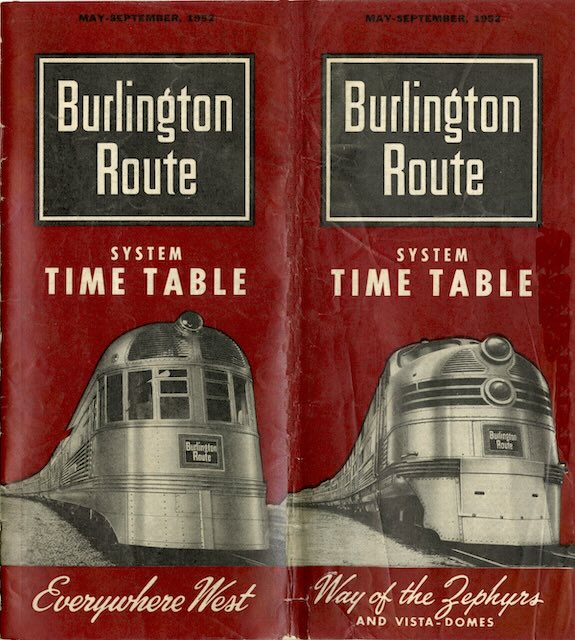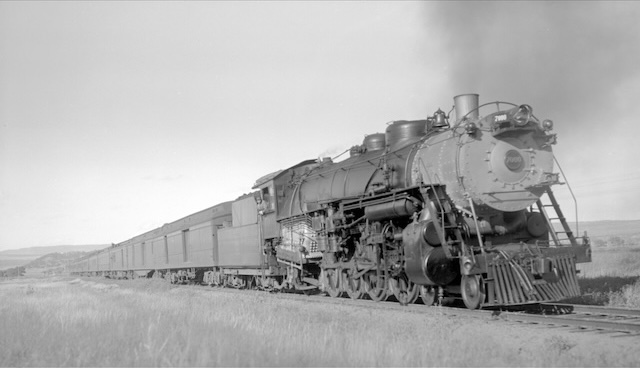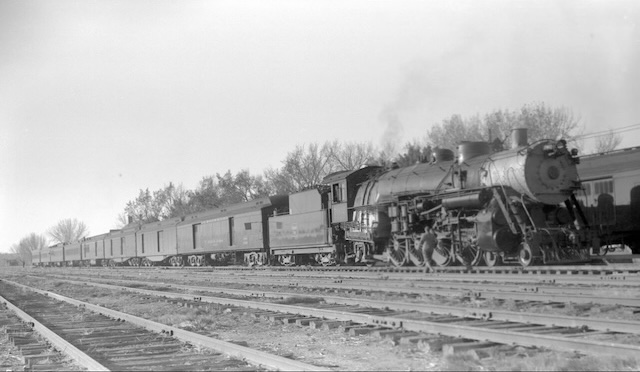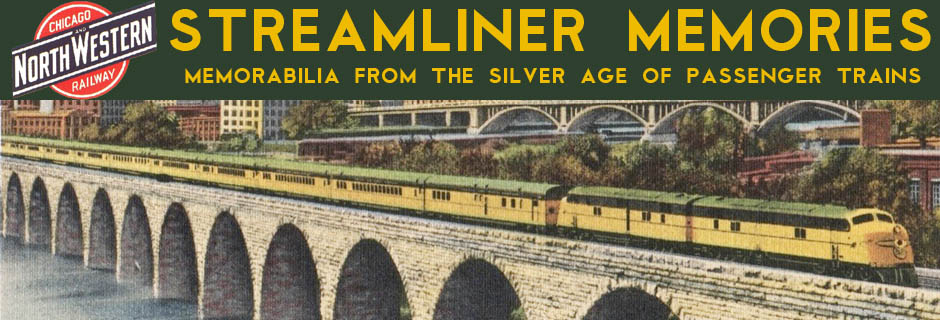As in May 1951, Burlington replaced its Zephyr back cover ad with one encouraging people to “Go West” on the Burlington. This one has a different graphic showing hikers and horseback riders in Colorado, Glacier, or some other mountainous region. As in the 1951 illustration, the horseback riders are carefully ignoring the hikers, who are photographing the horses (and wishing they could afford them) as they pass them by.
 Click image to download a 22.6-MB PDF of this 36-page timetable.
Click image to download a 22.6-MB PDF of this 36-page timetable.
This is the first Burlington timetable that shows the Western Star taking the longer route through Great Falls. That added 117 miles and two hours to the trip, though GN made up for the hours elsewhere in the Star‘s schedule. In any case, this didn’t result in any changes at Burlington’s end as it still combined the Western Star with the Black Hawk between Chicago and St. Paul.
One thing I’ve been meaning to mention is that train number 42 & 43, which went from Kansas City to Billings with a summer-only through sleeper to Glacier Park, is still on the schedule. This heavyweight train was once called the Adventureland, but the Burlington timetables stopped using that name in 1947.
Burlington subsidiary Burlington & Missouri River Railroad first reached Billings in 1894. The 1895 Official Guide shows trains 41 & 42 between Omaha and Billings. Trains 43 & 44 are also shown but they only went from Omaha to Grand Island, Nebraska. There were no through cars east from Omaha or west from Billings.
Starting in 1900, Burlington pages in the Official Guide showed trains 41 & 42 going through between Portland/Seattle and St. Louis. That wasn’t true, however. Instead, the Northern Pacific pages showed that NP trains 3 (Pacific Express) & 4 (Twin City Express) between Portland/Seattle and St. Paul handled through cars — Pullman, tourist, first-class, and second-class coaches — to Kansas City and St. Louis. By 1904, NP trains 5 & 6 sent through cars over the Burlington and NP even named them the Burlington Express in both directions. By 1910, NP Burlington’s train numbers, 41 & 42, and names, Puget Sound Express westbound and Mississippi Valley Express eastbound.
Great Northern reached Billings in 1909. In 1910, it began running trains 43 & 44 between Seattle and Kansas City. Though adopting Burlington’s train numbers, it used the names Great Northern Express westbound and Southeast Express eastbound. The train carried standard sleepers, tourist sleepers, and chair cars through between Kansas City and Seattle. This meant Burlington was now running two trains a day in each direction, with 41 & 42 going to Seattle over the NP and 43 & 44 going over the GN.
I’m missing Official Guides between 1911 and 1921, but at some point during that decade — probably during the war — Great Northern stopped carrying cars from the Burlington through to Seattle, probably because its route wasn’t competitive with NP’s: although it was only 50 miles longer, those were slow miles as the GN train from Billings took almost 4 hours longer to get to Seattle than the NP train. GN did carry a seasonal sleeping car on trains 43 & 44 between Kansas City and Glacier Park (Shelby in the off-season). Northern Pacific continued to run trains 41 & 42 with cars going through between Kansas City and Seattle.
Burlington’s 1928 timetables show trains 41 through 44 but don’t show through cars going west of Billings. However, Northern Pacific’s 1928 timetables show train 41 sending a through sleeper to Seattle via NP train 1, the North Coast Limited and NP train 4, the Atlantic Express, sending a through sleeper to Kansas City via Burlington train 42. Great Northern’s 1928 timetable continued to show trains 43 and 44 going as far west as Glacier Park.
As of 1930, passengers could take a through car from St. Louis to Seattle over the Burlington-NP, but this was cut back to Kansas City-Seattle (or Tacoma) in 1931 and Kansas City-Butte in 1938 or 1939.

Otto Perry photographed the eastbound Adventureland on June 10, 1938 after photographing the westbound train earlier the same day. Both trains were pulled by 4-8-2 locomotives, in this case #7000 while the westbound was pulled by 7001. While the trains had 8 or 9 cars in June, when he photographed the same train in October 1939 it only had five cars. Photo from Denver Public Library Special Collections; click image for a larger view.
Great Northern’s Kansas City-Glacier/Shelby car was dropped in 1933 and restored by 1937. In 1938 or 1939 it was cut back to Omaha-Glacier/Shelby. The railroads also often had a car going straight from Cody to Glacier, thus making it easier for Yellowstone tourists to visit Glacier on the same trip.

Perry photographed the westbound General Custer in Edgemont, SD, on October 22, 1939 after photographing the eastbound train earlier the same day. Again, both trains were pulled by 4-8-2 locomotives. A photo of the train in Billings shows just four cars, probably because the other cars had been transferred to the NP. Photo from Denver Public Library Special Collections; click image for a larger view.
Burlington’s 1937 timetable named trains 41 and 44 the General Custer while 42 and 43 became the Adventureland. Burlington timetables dropped the General Custer name and terminated that train in Edgemont, SD (and later Alliance, NE) in 1943. After that trains 42 and 43 connected with both GN and NP at Billings.
The Kansas City-Butte car was dropped at the end of 1941 and NP and Burlington no longer ran any through cars via Billings. Omaha-Glacier/Shelby lasted one year longer.
The Adventureland name remained in Burlington’s timetables through 1946. Probably due to a communications lag, Great Northern continued to use the Adventureland name in early 1948 but dropped it later that year.
The shortened trains 41 and 44 disappeared from the timetables in 1955. In about 1957, the eastern terminus of 42 and 43 was cut back to Lincoln and then Omaha. In 1968 or 1969 it was cut back further to Alliance where it connected with 41 & 44, which had been restored between Omaha and Alliance. Requiring passengers to change trains twice between Billings and Kansas City was probably a tactic aimed at reducing ridership so that Burlington could cut the trains. None of the 41-44 trains appear on my 1970 BN timetable.
Trains 41 through 44 were, of course, heavyweights. It is interesting to think that if they had been more successful in the late 1930s Burlington might have considered a Puget Sound Zephyr from Kansas City to Seattle over one or both of its parent railroads.
